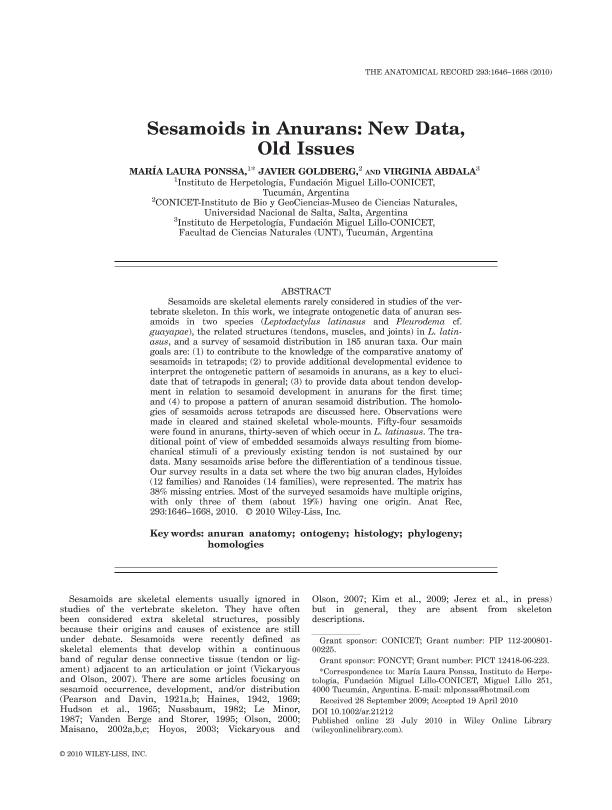Mostrar el registro sencillo del ítem
dc.contributor.author
Ponssa, María Laura

dc.contributor.author
Goldberg, Francisco Javier

dc.contributor.author
Abdala, Virginia Sara Luz

dc.date.available
2019-04-11T13:52:31Z
dc.date.issued
2010-10
dc.identifier.citation
Ponssa, María Laura; Goldberg, Francisco Javier; Abdala, Virginia Sara Luz; Sesamoids in anurans: New data, old issues; Wiley-liss, Div John Wiley & Sons Inc; Anatomical Record-Advances in Integrative Anatomy and Evolutionary Biology; 293; 10; 10-2010; 1646-1668
dc.identifier.issn
1932-8486
dc.identifier.uri
http://hdl.handle.net/11336/74021
dc.description.abstract
Sesamoids are skeletal elements rarely considered in studies of the vertebrate skeleton. In this work, we integrate ontogenetic data of anuran sesamoids in two species (Leptodactylus latinasus and Pleurodema cf. guayapae), the related structures (tendons, muscles, and joints) in L. latinasus, and a survey of sesamoid distribution in 185 anuran taxa. Our main goals are: (1) to contribute to the knowledge of the comparative anatomy of sesamoids in tetrapods; (2) to provide additional developmental evidence to interpret the ontogenetic pattern of sesamoids in anurans, as a key to elucidate that of tetrapods in general; (3) to provide data about tendon development in relation to sesamoid development in anurans for the first time; and (4) to propose a pattern of anuran sesamoid distribution. The homologies of sesamoids across tetrapods are discussed here. Observations were made in cleared and stained skeletal whole-mounts. Fifty-four sesamoids were found in anurans, thirty-seven of which occur in L. latinasus. The traditional point of view of embedded sesamoids always resulting from biomechanical stimuli of a previously existing tendon is not sustained by our data. Many sesamoids arise before the differentiation of a tendinous tissue. Our survey results in a data set where the two big anuran clades, Hyloides (12 families) and Ranoides (14 families), were represented. The matrix has 38% missing entries. Most of the surveyed sesamoids have multiple origins, with only three of them (about 19%) having one origin.
dc.format
application/pdf
dc.language.iso
eng
dc.publisher
Wiley-liss, Div John Wiley & Sons Inc

dc.rights
info:eu-repo/semantics/openAccess
dc.rights.uri
https://creativecommons.org/licenses/by-nc-sa/2.5/ar/
dc.subject
Anuran Anatomy
dc.subject
Histology
dc.subject
Homologies
dc.subject
Ontogeny
dc.subject
Phylogeny
dc.subject.classification
Otras Ciencias Biológicas

dc.subject.classification
Ciencias Biológicas

dc.subject.classification
CIENCIAS NATURALES Y EXACTAS

dc.title
Sesamoids in anurans: New data, old issues
dc.type
info:eu-repo/semantics/article
dc.type
info:ar-repo/semantics/artículo
dc.type
info:eu-repo/semantics/publishedVersion
dc.date.updated
2019-04-05T18:29:00Z
dc.journal.volume
293
dc.journal.number
10
dc.journal.pagination
1646-1668
dc.journal.pais
Estados Unidos

dc.description.fil
Fil: Ponssa, María Laura. Fundación Miguel Lillo. Dirección de Zoología. Instituto de Herpetología; Argentina. Consejo Nacional de Investigaciones Científicas y Técnicas; Argentina
dc.description.fil
Fil: Goldberg, Francisco Javier. Consejo Nacional de Investigaciones Científicas y Técnicas. Centro Científico Tecnológico Conicet - Salta. Instituto de Bio y Geociencias del NOA. Universidad Nacional de Salta. Facultad de Ciencias Naturales. Museo de Ciencias Naturales. Instituto de Bio y Geociencias del NOA; Argentina
dc.description.fil
Fil: Abdala, Virginia Sara Luz. Fundación Miguel Lillo. Dirección de Zoología. Instituto de Herpetología; Argentina. Consejo Nacional de Investigaciones Científicas y Técnicas; Argentina
dc.journal.title
Anatomical Record-Advances in Integrative Anatomy and Evolutionary Biology

dc.relation.alternativeid
info:eu-repo/semantics/altIdentifier/doi/http://dx.doi.org/10.1002/ar.21212
dc.relation.alternativeid
info:eu-repo/semantics/altIdentifier/url/https://onlinelibrary.wiley.com/doi/full/10.1002/ar.21212
Archivos asociados
